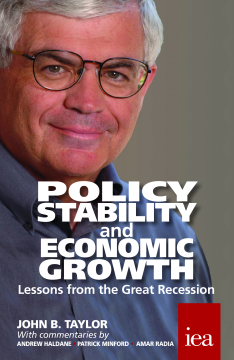
BOOK
Policy Stability and Economic Growth – Lessons from the Great Recession
John B. Taylor | Andrew G. Haldane | Patrick Minford
(2016)
Additional Information
Book Details
Abstract
John Taylor is one of the foremost economists of our generation. His ideas were implemented in central banks across the world during the period of price stability, economic growth and financial stability that followed the 1980s. Of course, this period culminated in the financial crisis of 2008, which was followed by a very slow recovery, which, eight years on, can hardly be said to be complete. This short book presents Taylor’s view of the financial crisis and its aftermath as expressed in the 2014 F. A. Hayek Memorial Lecture. He believes that the rules-based monetary policy that he espoused broke down in the run-up to the crisis and afterwards. Furthermore, other aspects of policy became erratic and discretionary to the point that the rule of law could be said to be under threat. According to the author, these problems contributed to the crisis and to the slow recovery – indeed, they were a major cause. Two commentaries follow John Taylor’s lecture. One is by Patrick Minford and the other is by the Bank of England’s Chief Economist Andrew Haldane and Amar Radia. Both recognise Taylor’s immense contribution to economic theory and policy. The commentaries are themselves an important contribution and they are followed by a response from John Taylor which addresses the issues raised by the commentators.
Table of Contents
| Section Title | Page | Action | Price |
|---|---|---|---|
| The authors | ix | ||
| Foreword | xi | ||
| Acknowledgement | xvi | ||
| Summary | xvii | ||
| Tables and figures | xx | ||
| 1\tPolicy stability and economic growth: lessons from the Great Recession | 1 | ||
| Introduction | 1 | ||
| The Great Recession compared with earlier recessions | 2 | ||
| The principles of good policy | 6 | ||
| Monetary policy: to the Taylor rule and back | 10 | ||
| Very unruly policy | 17 | ||
| A return to rules-based policy | 22 | ||
| References | 26 | ||
| 2\tQuestions and discussion | 27 | ||
| 3\tWas failure to follow the Taylor rule enough to cause the crisis? | 37 | ||
| A commentary on John Taylor’s lecture | 37 | ||
| Patrick Minford | 37 | ||
| Evaluating John Taylor’s particular thesis about the financial crisis | 40 | ||
| Did the Taylor rule with inflation targeting fail during and before the crash? | 42 | ||
| John Taylor’s plea for a return to predictable rules of policy | 46 | ||
| Conclusions | 49 | ||
| References | 50 | ||
| 4\tThe need for discretion and rules | 52 | ||
| A commentary on John Taylor’s lecture | 52 | ||
| Andrew G. Haldane and Amar Radia | 52 | ||
| Rules and discretion revisited | 53 | ||
| Monetary policy rules in practice | 63 | ||
| Concluding remarks | 76 | ||
| References | 77 | ||
| 5\tA rejoinder | 81 | ||
| John B. Taylor | 81 | ||
| Reference | 85 | ||
| About the IEA | 86 | ||
| Figure 1\tGreat Recession and not-so-great recovery (US) | 3 | ||
| Figure 2\tGreat Recession and not-so-great recovery (UK) | 4 | ||
| Figure 3\tUS recession and recovery in early 1980s | 5 | ||
| Figure 4\tUK recession and recovery in early 1980s | 6 | ||
| Figure 5\tGrowth rate in first eight quarters of a recovery from previous recessions with a financial crisis (identified by year recession began) | 7 | ||
| Figure 6\tInflation from 1953 to 2013 | 10 | ||
| Figure 7\t1965–80: monetary policy not well described by good rules-based policy | 13 | ||
| Figure 8\tLoose-fitting monetary policy | 14 | ||
| Figure 9\tHousing investment versus deviations from the Taylor rule in the euro zone countries, 2001–6 | 15 | ||
| Figure 10\tDid the fiscal stimulus stimulate consumption? | 19 | ||
| Figure 11\tDebt to GDP ratio in the US | 20 | ||
| Figure 12\tIncidence of topics affecting inflation discussed by the MPC | 59 | ||
| Figure 13\tIncidence of topics linked to the labour market discussed by the MPC | 60 | ||
| Figure 14\tDistribution of inflation and growth outcomes relative to forecast | 61 | ||
| Figure 15\tActual and Taylor rule paths for UK interest rates | 67 | ||
| Figure 16\tTaylor rule paths for UK interest rates with different judgements about the output gap | 68 | ||
| Figure 17\tTaylor rules for UK interest rates with different judgements about weight on output gap | 69 | ||
| Figure 18\tTaylor rules paths for interest rates with different judgements about r* | 71 | ||
| Figure 19\tBank of England inflation forecasts | 73 | ||
| Figure 20\tTaylor rules paths for interest rates with different judgements about forward lookingness | 74 | ||
| Figure 21\tRange of possible Taylor rules based on different judgements | 75 | ||
| Table 1\tSimulated frequencies of crises with different monetary regimes | 43 | ||
| Blank Page | ii |
